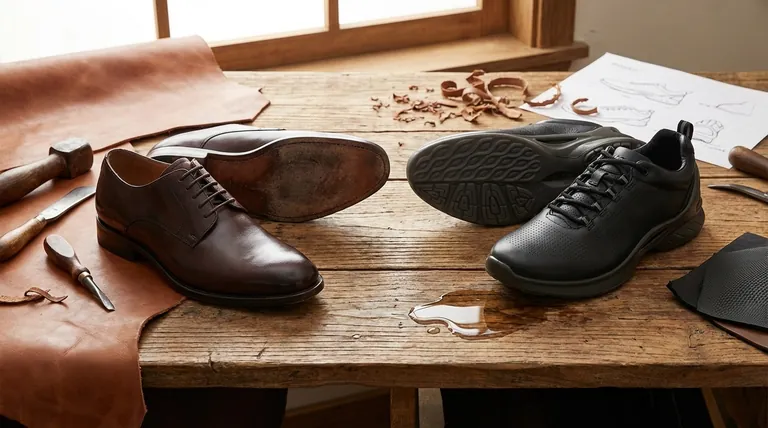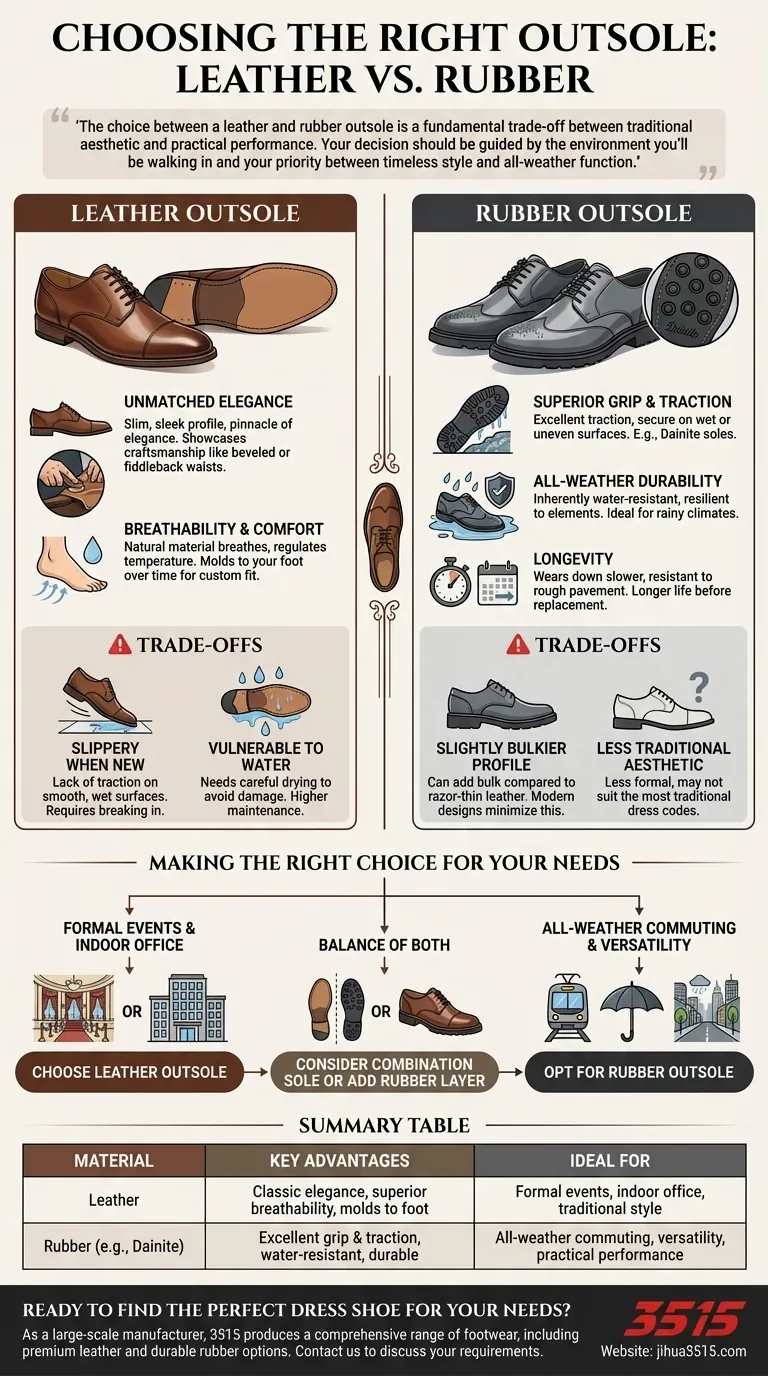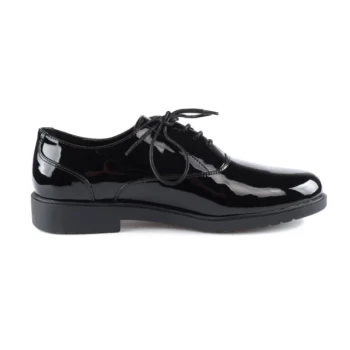When selecting a dress shoe, the outsole material is a critical detail that dictates both its appearance and performance. The two most common materials are leather, chosen for its classic elegance and flexibility, and rubber (such as Dainite), which offers superior grip, water resistance, and durability.
The choice between a leather and rubber outsole is a fundamental trade-off between traditional aesthetic and practical performance. Your decision should be guided by the environment you'll be walking in and your priority between timeless style and all-weather function.

The Case for the Leather Outsole
A leather outsole is the traditional and most formal choice for high-quality dress shoes. Its advantages are rooted in craftsmanship, comfort, and classic style.
Unmatched Elegance
Leather soles offer a slim, sleek profile that is considered the pinnacle of elegance in dress footwear.
High-end shoemakers often showcase their craft through details on the sole, such as a beveled or fiddleback waist, which are hallmarks of quality construction.
Breathability and Comfort
As a natural material, leather breathes. This helps regulate temperature and moisture, contributing to greater comfort over a full day of wear. Over time, a leather sole will also mold to the shape of your foot.
The Practicality of the Rubber Outsole
While less traditional, rubber outsoles have become a popular and highly functional option for modern dress shoes, prized for their resilience and grip.
Superior Grip and Traction
The primary advantage of a rubber outsole is its excellent traction. Materials like Dainite provide a secure grip on a variety of surfaces, including those that are wet or uneven.
All-Weather Durability
Rubber is inherently water-resistant and far more resilient to the elements than leather. This makes it an ideal choice for commuters or anyone living in a climate with frequent rain.
Longevity
A quality rubber sole often wears down more slowly than a leather sole, especially when subjected to rough pavement or frequent use, leading to a longer life before needing replacement.
Understanding the Trade-offs
Neither material is perfect for every situation. Acknowledging their inherent limitations is key to making an informed choice.
The Slippery Nature of Leather
The most significant drawback of a leather sole is its lack of traction, especially when new. It can be quite slippery on smooth, wet surfaces like marble or tile.
The Profile of Rubber
While modern designs are very sleek, rubber soles can sometimes add slightly more bulk to a shoe's profile compared to the razor-thin appearance of a classic leather sole.
Maintenance and Vulnerability
Leather soles require more care. If they become soaked, they must be allowed to dry naturally and completely to avoid damage, whereas rubber is largely impervious to water.
Making the Right Choice for Your Needs
Your ideal outsole depends entirely on how and where you plan to wear your shoes.
- If your primary focus is formal events and indoor office wear: Choose a leather outsole for its unmatched elegance and classic silhouette.
- If your primary focus is all-weather commuting and versatility: Opt for a rubber outsole for its superior grip, durability, and water resistance.
- If you seek a balance of both: Consider shoes with a combination leather-and-rubber sole, or purchase a leather-soled pair and have a cobbler add a thin rubber layer for protection and grip.
Understanding the function of your outsole empowers you to invest in a shoe that performs as well as it looks.
Summary Table:
| Material | Key Advantages | Ideal For |
|---|---|---|
| Leather | Classic elegance, superior breathability, molds to your foot | Formal events, indoor office wear, traditional style |
| Rubber (e.g., Dainite) | Excellent grip & traction, water-resistant, durable & long-lasting | All-weather commuting, versatility, practical performance |
Ready to find the perfect dress shoe for your needs?
As a large-scale manufacturer, 3515 produces a comprehensive range of footwear for distributors, brand owners, and bulk clients. Our production capabilities encompass all types of shoes and boots, including premium leather-soled dress shoes and durable rubber-soled options.
We can help you source or create the ideal footwear to meet your market's demands for both style and function. Contact our team today to discuss your requirements and discover how we can add value to your business.
Visual Guide

Related Products
- Wholesale Comfortable Business Casual Shoes Custom Manufacturing
- Wholesale Patent Oxford Dress Shoes | Custom & Bulk Manufacturing
- Wholesale Modern Comfort Shoes with Dial Closure for Private Label & Bulk Orders
- Safety Footwear Wholesale Manufacturer for Custom OEM/ODM Production
- Custom OEM Training Shoes Wholesale Manufacturer Durable & Breathable
People Also Ask
- Are brown dress shoes appropriate for formal events? A Guide to Choosing the Right Shoe
- What is business casual shoes? Master the Perfect Blend of Professional Style and Comfort
- What are the long-term benefits of investing in quality dress shoes? Save Money & Boost Your Style
- What should someone do if they are unsure about a company's dress code? Navigate with Confidence
- Why is comfort important in dress shoes? Achieve All-Day Support for Professional Performance



















